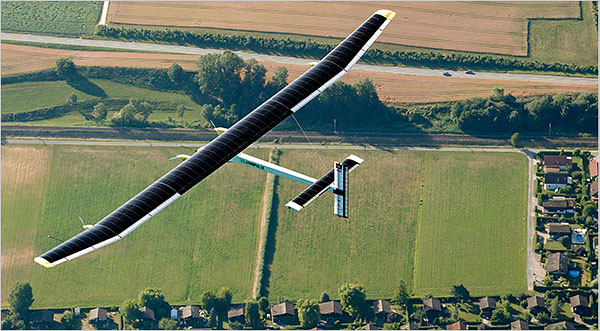PARIS — Slender as a stick insect, a solar-powered experimental airplane with a huge wingspan completed its first test flight of more than 24 hours on Thursday, powered overnight by energy collected from the sun during a day aloft over Switzerland.
The organizers said the flight was the longest and highest by a piloted solar-powered craft, reaching an altitude of just over 28,000 feet above sea level at an average speed of 23 knots, or about 26 miles per hour.
The plane, Solar Impulse, landed where it had taken off 26 hours and 9 minutes earlier, at Payerne, 30 miles southwest of the capital, Bern, after gliding and looping over the Jura Mountains, its 12,000 solar panels absorbing energy to keep its batteries charged when the sun went down.
The pilot, André Borschberg, 57, a former Swiss Air Force fighter pilot, flew the plane from a cramped, single-seat cockpit, buffeted by low-level turbulence after takeoff and chilled by low temperatures overnight.
“I’ve been a pilot for 40 years now, but this flight has been the most incredible one of my flying career,” Mr. Borschberg said as he landed, according to a statement from the organizers of the project. “Just sitting there and watching the battery charge level rise and rise, thanks to the sun.” He added that he had flown the entire trip without using any fuel or causing pollution. The project’s co-founder, Dr. Bertrand Piccard, who achieved fame by completing the first nonstop, round-the-world flight by hot air balloon in 1999, embraced the pilot after he landed the plane to the cheers of hundreds of supporters.
“When you took off, it was another era,” The Associated Press quoted Dr. Piccard as saying. “You land in a new era where people understand that with renewable energy you can do impossible things.”
The project’s designers had set out to prove that — theoretically at least — the plane, with its airliner-size, 208-foot wingspan, could stay aloft indefinitely, recharging batteries during the day and using the stored power overnight. “We are on the verge of the perpetual flight,” Dr. Piccard said.
The project’s founders say their ambition is for one of their craft to fly around the world using solar power. The propeller-driven Solar Impulse, made of carbon fiber, is powered by four small electric motors and weighs around 3,500 pounds. During its 26-hour flight, the plane reached a maximum speed of 68 knots, or 78 miles per hour, the organizers said.
The seven-year-old project is not intended to replace jet transportation — or its comforts.
Just 17 hours after takeoff, a blog on the project’s Web site reported, “André says he’s feeling great up there.”
It continued: “His only complaints involve little things like a slightly sore back as well as a 10-hour period during which it was minus 20 degrees Celsius in the cockpit.”
That made his drinking water system freeze, the post said and, worst of all, caused his iPod batteries to die.



